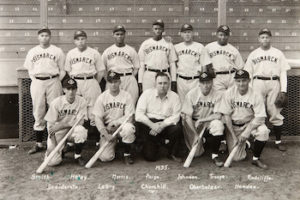
The Bismark Grays, 1935
*The Bismarck Grays are celebrated on this date in 1935. They were a North Dakota-integrated national semi-pro baseball team.
Neil Churchill moved to Bismarck in 1919 and began playing for a city team called the Grays. By 1926, Churchill was named team manager, and he decided to eliminate the previous practice of paying some of the ballplayers, returning the team to amateur status. Slowly, the team became highly competitive, and in 1933, Bismarck was locked into a fierce rivalry with Jamestown over North Dakota bragging rights.
In July, following a disappointing loss to Jamestown, which had previously integrated its team with several Negro League All-Stars, Churchill reversed himself. He returned the team to semi-professional status, paying the players himself. Through his friendship with Abe Saperstein, the owner of the Harlem Globetrotters basketball team, Churchill lured Satchel Paige and three other Negro League players to Bismarck. Paige won seven games in August, and the team finished the 1933 season with a 38-12-5 record, claiming the state championship.
Pictured above is Bismarck’s 1935 National Semi-Pro Championship team. According to Tom Dunkel, author of Color Blind, this is the only known picture of the team, taken a few weeks before they left for the National Tournament. Kneeling left to right are Joe Desiderato, Al Leary, Neil Churchill, Dan Oberholzer, and Ed Hendee. Standing left to right are Hilton Smith, Red Haley, Barney Morris, Satchel Paige, Moose Johnson, Quincy Troupe, and Double Duty Radcliffe. In the back row, Moose Johnson has his right hand on Satchel Paige’s left shoulder in a gesture that designates acceptance and friendship between the two players. Today, baseball historians point to the 1935 national championship team as pivotal in the integration of major league baseball.
Although it would be another 12 years before Jackie Robinson would integrate Major League Baseball, Churchill, Paige, and their Bismarck team gave baseball a glimpse into the future of integrated baseball. Years later, Paige described the team as the “best he ever saw,” and official Major League historian John Thorn described the 1935 team as “the most dominant baseball team in the country, including the major leagues.